Orang Asli
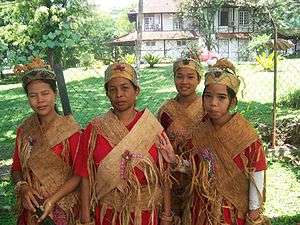 A group of Orang Asli from Malacca in folk costume | |
| Total population | |
|---|---|
| 178,197 (2010)[1] | |
| Regions with significant populations | |
|
| |
| Languages | |
|
Aslian languages (Austroasiatic) Aboriginal Malay languages (Austronesian) | |
| Religion | |
| Animism, Christianity, Islam | |
| Related ethnic groups | |
|
Semang, Senoi, and Proto Malay of Peninsular Malaysia Maniq of southern Thailand Talang Mamak, Akit, Sakai of Sumatera, Indonesia |
Orang Asli (lit. "original people", "natural people" or "aboriginal people" in Malay) are the indigenous people and the oldest inhabitants of Peninsular Malaysia. Officially, there are 18 Orang Asli tribes, categorised under three main groups according to their different languages and customs:
- Semang (or Negrito), generally confined to the northern portion of the peninsula.
- Senoi, residing in the central region.
- Proto-Malay (or Aboriginal Malay), in the southern region.
The Semang and Senoi groups, being Austroasiatic-speaking, are the indigenous peoples of the Malay Peninsula. The Proto-Malays, who speak Austronesian languages, migrated to the area between 2500 and 1500 BC.
There is an Orang Asli museum in Melaka, and also in Gombak, about 25 km north of Kuala Lumpur.
History
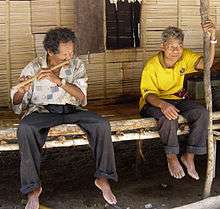
The Orang Asli kept to themselves until the first traders from India arrived in the first millennium CE.[2] Living in the interior, they bartered inland products like resins, incense woods, and feathers for salt, cloth, and iron tools.
The rise of Hindu-Buddhist and later Islamic Malay kingship system during the common era forever revolutionised the dynamics of Malay Peninsular society. With the easement of mobility and contact between various groups of people, the walls that separated the myriad of historical Austroasiatic and Austronesian tribal communities who once dwelled across the peninsular were dismantled, being gradually drawn and integrated into the Malay society, identity, language, culture and belief system. These Malayised tribes and communities would later constitute among the ancestors of present-day Malay people. Other smaller, closely related tribes, often located further inland compared to their coastal cousins managed to be spared from the Malayisation process due to their secluded geographical location and nomadic and semi-nomadic lifestyle, hence preserving and developing their own endemic language, customs and pagan rituals.[3][4][5]
_(14779130654).jpg)
Some of these Orang Asli groups were not living in complete isolation from their Malayalised brothers, they engaged with economic dealings and trading with the Malays, jungle produce provided by the Orang Aslis was traded in exchange for vital commodities such as salt, knives and metal axe-heads by the Malays. Historical record also witnessed that the Orang Asli sent forest produce as a tribute to the Malay chiefs where they reside in.[6][4]
By the 18th to the 19th century, some Orang Asli groups suffered raids by the Malay and Batak forces who perceived them to be of lower in status. The Orang Asli settlement being sacked, with the adult males being systematically executed while the women and children being held captive and later sold as slaves.[6][7] However, the relationship between the Malays and Orang Asli were not always hostile, many other groups enjoyed peaceful and cordial relation with their Malay neighbours.[3]
The arrival of British colonists brought further inroads in the lives of Orang Asli. They were targeted by Christian missionaries and became subjects of anthropological research.[8]
During the Malayan Emergency of 1948 to 1960, the Orang Asli became a vital component of national security, as their help enabled the Malayan army to defeat the Communist insurgents. Two administrative initiatives were introduced to highlight the importance of the Orang Asli, as well to protect their identity. The Department of Aborigines was established in 1950, and the Aboriginal Peoples Ordinance was enacted in 1954. After independence, development of the Orang Asli became a prime objective of the government, and in 1961 a policy was adopted to integrate the Orang Asli into the wider Malaysian society.[8]
In the 1970s and 1980s, Malaysia experienced a period of sustained growth characterised by modernisation, industrialisation, and land development, which resulted in encroachments on Orang Asli land. In response to this encroachment, the Orang Asli mobilised and formed the Peninsular Malaysia Orang Asli Association (POASM), which has given them a stronger voice and greater visibility. The Orang Asli are now known as Orang Kita ("our people") following the introduction of the "One Malaysia" concept by Najib Razak.[8]
Economy
Orang Asli living in remote forest areas engaged in some trading with the Malays, with jungle produce being exchanged for salt, knives and metal axe-heads. There was also evidence of trade in blowpipes and blowpipe-bamboo among certain tribes. It has also been shown that the Orang Asli have played a significant role in the Malay Peninsula's economic history as collectors and primary traders as early as the 5th Century A.D. An early 19th century report also tells of Negritos providing forest products as tribute to the Malay chiefs of the river basins they resided in.[6]
Demography
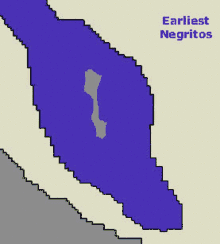
In 2000, the Orang Asli constitute only 0.5% of the total population in Malaysia.[2] Their population is approximately 148,000.[9] The largest group are the Senois, constituting about 54% of the total Orang Asli population. The Proto-Malays form 43%, and the Semang forming 3%.[9] Thailand is home to roughly 600 orang asli, divided between Mani people with Thai citizenship, and 300 others in the deep south.[10]
The poverty rate among Orang Asli is 76.9%.[1] In addition to this high rate, the Statistics Department of Malaysia has classified 35.2% of the population as being "very poor". The majority of Orang Asli live in rural areas, while a minority have moved into urban areas. In 1991, the literacy rate for the Orang Asli was 43% compared to the national rate of 86% at that time.[1] They have an average life expectancy of 53 years (52 for male and 54 for female). A high infant mortality rate is also evident with 51.7 deaths per 1000 births.[11]
The Malaysian Government has undertaken various measures to eradicate the poverty level among the Orang Aslis, many of them have been relocated from their nomadic and semi-nomadic dwelling to a permanent housing estate under the relocation program initiated by the government.[12] These settlements are equipped with modern amenities including electricity, running water and school. They were also awarded plots of palm oil land to be cultivated and as a source of income.[13] Other programs initiated by the government includes various special scholarship for the Orang Asli children for their studies and entrepreneurship courses, training and monetary funds for Orang Asli adult.[14][15] The Malaysian Government aims to increase the monthly household income for Orang Asli from RM 1,200.00 per-month in 2010 to RM 2,500.00 by year 2015.
| Orang Asli population by groups and subgroups (2000)[16] | |||
| Negrito | Senoi | Proto Malay | |
|---|---|---|---|
| Bateq (1,519) | Cheq Wong (234) | Jakun (21,484) | |
| Jahai (1,244) | Jah Hut (2,594) | Orang Kanaq (73) | |
| Kensiu (254) | Mah Meri (3,503) | Orang Kuala (3,221) | |
| Kintaq (150) | Semai (34,248) | Orang Seletar (1,037) | |
| Lanoh (173) | Semaq Beri (2,348) | Semelai (5,026) | |
| Mendriq (167) | Temiar (17,706) | Temuan (18,560) | |
| 3,507 | 60,633 | 49,401 | |
| Total: 113,541‡ | |||
Languages
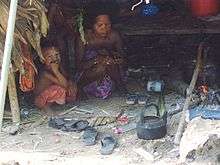
The division of Orang Asli into three categories is not due to linguistic differences but is merely sociological: linguistically they divide into two groups.
The first group speak Aslian languages, which form part of the Austroasiatic language family. These are further divided into the Jahaic languages (North Aslian), Senoic languages, Semelaic languages (South Aslian), and Jah Hut.[17] The languages which fall under the Jahaic language sub-group are the Cheq Wong, Jahai, Bateq, Kensiu, Kintaq, and Mendriq languages. The Lanoh language, Temiar language, and Semai language fall into the Senoic language sub-group. Languages that fall into the Semelaic sub-group include the Semelai language, Semoq Beri language, and Besisi language (language spoken by the Mah Meri people).
The second group speak Aboriginal Malay languages, which form part of the Austronesian language family. These include the Jakun and Temuan languages among others.[18]
Besides these, most Orang Aslis are fluent in the Malay language, the official language of Malaysia.
Lifestyle and religion
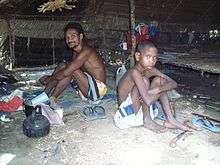
Orang Asli are traditionally animists, where they believe in the presence of spirits in various objects.[19] However, in the 21st century, many of them have embraced monotheistic religions such as Islam and Christianity[19] following some active state-sponsored dakwah by Muslims, and evangelism by Christian missionaries.[20]
In June 2007, an Orang Asli church was allegedly torn down by the state government in Gua Musang, Kelantan. As of 2008, a suit has been filed against the Kelantan state authorities. The affected Orang Asli also sought a declaration under Article 11 of the Constitution of Malaysia that they have the right to practice the religion of their choice and to build their own prayer house.[21]
Negritos of Peninsular Malaysia
According to the Encyclopedia of Malaysia, the Negritos, who number approximately 2,000, are regarded as the earliest inhabitants of the Malay Peninsula. They are of Australo-Melanesian affinity and probably descend from the people of Hoabinhian cultural period, with many of their burials found dating back 10,000 years ago. They speak the Aslian languages which is part of the Austroasiatic language family, as do their Senoi agriculturalist neighbours. Negritos belong to various subgroups, namely the Kensiu, Kintak, Lanoh, Jahai, Jakun, Mendriq and Bateq. Those from Perak, Kedah and Pahang are also known as Sakai, the meaning of "Sakai" is debt slaves, while those from Kelantan and Terengganu were called Pangan, the forest peoples. The Senoi and Proto-Malay arrived much later probably during the Neolithic period.
Social and legal status
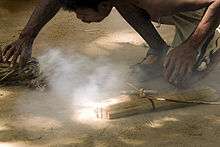
The government agency entrusted to oversee the affairs of the Orang Asli is the Jabatan Hal Ehwal Orang Asli (Department of Orang Asli Affairs) (JHEOA). This body is under the Malaysian Ministry of Rural Development, and it was first set up in 1954.[22] Among its stated objectives are to eradicate poverty among the Orang Asli, improving their health, promoting education, and improving their general livelihood. There is a high incidence of poverty among the Orang Asli. In 1997, 80% of all Orang Asli lived below the poverty line. This ratio is extremely high compared to the national poverty rate of 8.5% at that time.[23]
Some legislations which concerns Orang Asli are the National Land Code 1965, Land Conservation Act 1960, Protection of Wildlife Act 1972, National Parks Act 1980, and most importantly the Aboriginal Peoples Act 1954. The Aboriginal Peoples Act 1954 provides for the setting up and establishment of the Orang Asli Reserve Land. However, the Act also includes the power accorded to the Director-General of the JHEOA to order Orang Asli out of such reserved land at its discretion, and award compensation to affected people, also at its discretion.[24] A landmark case on this matter is in the 2002 case of Sagong bin Tasi & Ors v Kerajaan Negeri Selangor. The case was concerned with the state using its powers conferred under the 1954 Act to evict Orang Asli from gazetted Orang Asli Reserve Land. The High Court ruled in favour of Sagong Tasi, who represented the Orang Asli, and this decision was upheld by the Court of Appeal.[24]
.jpg)
The Orang Asli are classified as Bumiputras,[20] a status signifying indigenity to Malaysia which carries certain social, economic, and political rights, along with the Malays and the natives of Sabah and Sarawak. However, this status is generally not mentioned in the constitution.[20]
The former Prime Minister of Malaysia, Dr. Mahathir Mohamad, made controversial remarks regarding the Orang Asli, saying that Orang Asli were not entitled more rights than Malays even though they were natives to the land, as posted on his blog comparing the Orang Asli in Malaysia to Native Americans in the US, Māori in New Zealand, and Aboriginal Australians.[26][27] He was criticised by spokespeople and advocates for the Orang Asli who said that the Orang Asli desired to be recognised as the true natives of Malaysia and that his statement would expose their land to businessmen and loggers.[28][29]
A major scandal involving the deaths of several escapee Orang Asli students led to a discussion over the role of religious indoctrination in schools.[30]
MUIP filed new Muslim converts from the Orang Asli.[31] The Kelantan state government was sued due to a dispute over land by Orang Asli.[32]
Notable Orang Aslis
- Amani Williams Hunt Abdullah, Orang Asli politician and Orang Asli activist, born to an English father and a Semai mother.
See also
References
- 1 2 3 Colin Nicholas (20 August 2012). "A Brief Introduction: The Orang Asli Of Peninsular Malaysia". Center for Orang Asli Concerns. Retrieved 14 June 2018.
- 1 2 Gomes, Alberto G. "The Orang Asli of Malaysia" (PDF). International Institute for Asian Studies. Retrieved 2 February 2008.
- 1 2 Idris Musa (23 July 2017). "Bermoyang Orang Asli". Harian Metro. Retrieved 2017-11-23.
- 1 2 "Bangsa Melayu keturunan Orang Asli Asal". Utusan Melayu. 16 April 2015. Retrieved 2017-11-23.
- ↑ Rahimah A. Hamid, Mohd Kipli Abdul Rahman & Nazarudin Zainun (2013). Kearifan Tempatan: Pengalaman Nusantara: Jilid 3 - Meneliti Khazanah Sastera, Bahasa dan Ilmu. Penerbit USM. ISBN 98-386-1672-9.
- 1 2 3 Colin Nicholas (1997). "The Orang Asli of Peninsula Malaysia". Magick River. Retrieved 2016-12-22.
- ↑ "Malaysia - Orang Asli". Minority Rights Group International. Retrieved 5 January 2017.
- 1 2 3 "Indigenous Politics, Development and Identity in Peninsular Malaysia: the Orang Asli and the Contest for Resources" (PDF). Commonwealth Policy Studies Unit. Archived from the original (PDF) on 16 February 2008. Retrieved 4 February 2008.
- 1 2 "Origins, Identity and Classification". Center for Orang Asli Concerns. Retrieved 2 February 2008.
- ↑ https://www.bangkokpost.com/news/special-reports/1442986/orang-asli-adapt-to-new-lifestyle-in-south
- ↑ "The Orang Asli of Peninsular Malaysia". University of Essex Malaysian Society Conference 2008. Retrieved 22 February 2008.
- ↑ Haradian Shah Hamdan (1 June 2016). "Kerajaan sedia rumah moden Orang Asli". Utusan Melayu. Retrieved 2017-11-23.
- ↑ "Pembalakan ancam kehidupan moden orang asli Sungai Rual". mStar. 5 October 2009. Archived from the original on 21 October 2016. Retrieved 2017-11-23.
- ↑ "Program Bantuan Pendidikan". JAKOA. Retrieved 2017-11-23.
- ↑ "Usahawan". JAKOA. Retrieved 2017-11-23.
- ↑ "Orang Asli Population Statistics". Center for Orang Asli Concerns. Archived from the original on 9 February 2012. Retrieved 11 April 2017.
- ↑ "Aslian language family tree". Ethnologue. Retrieved 12 February 2008.
- ↑ "Aboriginal Malay language family tree". Ethnologue. Retrieved 12 February 2008.
- 1 2 "Orang Asli". Adherents.com. Retrieved 12 February 2008.
- 1 2 3 Nicholas, Colin. "Orang Asli and the Bumiputra policy". Center for Orang Asli Concerns. Retrieved 12 February 2008.
- ↑ "Orang Asli file suit over church demolition". New Straits Times. Archived from the original on 18 January 2008. Retrieved 12 February 2008.
- ↑ "Livelihood & Indigenous Community Issues". JHEOA. February 2004. Archived from the original (PDF) on 27 February 2009. Retrieved 2017-11-23.
- ↑ "Chapter 4: Indigenous Peoples". Archived from the original on 25 October 2009. Retrieved 2017-11-23.
- 1 2 "The Law on Natural Resource Management". Center for Orang Asli Concerns. Retrieved 2 February 2008.
- ↑ Aurora (10 October 2011). "Lynas And The Malaysian Green Movement — Kua Kia Soong". Malaysia Today. Retrieved 2018-01-23.
- ↑ Aurora (11 March 2011). "Mahathir Justifies Asli Oppression". Malaysia Today. Retrieved 2017-11-23.
- ↑ VWArticles (15 May 2014). "Mahathir: Malay Claims to Country Stronger Than Orang Asli". Value Walk. Retrieved 2017-11-23.
- ↑ Karen Arukesamy (15 March 2011). "Mahathir slammed for belittling Orang Asli". thesundaily (Sun2Surf). Archived from the original on 17 March 2011. Retrieved 10 April 2011.
- ↑ Karen Arukesamy (15 May 2011). "Mahathir slammed for belittling Orang Asli". Asia Indigenous Peoples Pact. Retrieved 2017-11-23.
- ↑ http://www.thenutgraph.com/orang-asli-converted-against-will/ https://www.facebook.com/TeresaKokSuhSim/videos/vb.117300344947762/887245051286617/?type=2&theater http://www.asianews.it/news-en/Award-for-those-who-marry-and-convert-indigenous-animists-to-Islam-6557.html https://minpaku.repo.nii.ac.jp/index.php?action=pages_view_main&active_action=repository_action_common_download&item_id=3967&item_no=1&attribute_id=18&file_no=1&page_id=13&block_id=21 https://www.malaysiakini.com/news/212715 http://www.aljazeera.com/indepth/features/2015/10/malaysia-outrage-5-indigenous-children-die-151015094936769.html http://www.thenutgraph.com/orang-asli-converted-against-will/ http://www.aljazeera.com/indepth/features/2016/01/malaysia-forgotten-indigenous-children-160121115817325.html http://news.asiaone.com/news/malaysia/school-failed-look-after-our-children-say-grief-stricken-orang-asli http://asiapacific.anu.edu.au/newmandala/2016/03/03/an-education-in-captivity/ http://www.asiasentinel.com/society/malaysia-educational-genocide/ http://www.themalaymailonline.com/malaysia/article/found-orang-asli-girl-claims-only-she-and-another-the-only-ones-alive http://www.themalaymailonline.com/malaysia/article/two-of-seven-missing-orang-asli-children-found-alive-in-kelantan-report-say http://www.bfm.my/the-sad-state-of-orang-asli-children-and-their-education-shaq-koyok-suhakam-hasmah-manaf.html http://atimes.com/2015/10/outrage-over-death-of-5-kids-who-hid-in-jungle-for-weeks-to-escape-punishment/ http://www.thestar.com.my/news/nation/2015/10/10/kids-survive-46-days-in-the-jungle-two-orang-asli-children-found-emaciated-but-alive-in-unforgiving/ http://www.themalaysianinsider.com/malaysia/article/missing-orang-asli-children-cannot-survive-in-jungle-says-community-leader https://www.malaysiakini.com/news/212654
- ↑ Bernama (19 May 2016). "253 Orang Asli in Pahang convert to Islam in 2015". Malaysia Kini. Retrieved 2016-12-22.
- ↑ Alyaa Azhar (30 May 2016). "Temiar Orang Asli get day in court against Kelantan gov't". Malaysia Kini. Retrieved 2016-12-22.
Further reading
- Benjamin, Geoffrey & Cynthia Chou, ed. (2002), Tribal Communities in the Malay World: Historical, Social and Cultural Perspectives, Leiden: International Institute for Asian Studies (IIAS) / Singapore: Institute of Southeast Asian Studies (ISEAS), p. 490, ISBN 978-9-812-30167-3
- Benjamin, Geoffrey (1985). Karl L. Hutterer, A. Terry Rambo & George Lovelace, ed. "In the long term: three themes in Malayan cultural ecology". Cultural Values and Human Ecology in Southeast Asia. Ann Arbor MI: Center for South and Southeast Asian Studies, University of Michigan: 219–278. doi:10.13140/RG.2.1.3378.1285. ISBN 978-0-891-48040-2.
- Benjamin, Geoffrey (2013). Ooi Keat Gin, ed. "Orang Asli". Southeast Asia: A Historical Encyclopedia from Angkor Wat to East Timor. Santa Barbara CA: ABC-CLIO. Volume 2: 997–1000. ISBN 978-1-576-07770-2.
- Benjamin, Geoffrey (2013). "Why have the Peninsular "Negritos" remained distinct?". Human Biology. 85: 445–484. doi:10.3378/027.085.0321. ISSN 0018-7143.
- Orang Asli Now: The Orang Asli in the Malaysian Political World, Roy Jumper ( ISBN 0-7618-1441-8).
- Power and Politics: The Story of Malaysia's Orang Asli, Roy Jumper ( ISBN 0-7618-0700-4).
- 1: Malaysia and the Original People, p. 21. Robert Dentan, Kirk Endicott, Alberto Gomes, M.B. Hooker. ( ISBN 0-205-19817-1).
- Encyclopedia of Malaysia, Vol. 4: Early History, p. 46. Edited by Nik Hassan Shuhaimi Nik Abdul Rahman ( ISBN 981-3018-42-9).
- Abdul Rashid, M. R. b. H., Jamal Jaafar, & Tan, C. B. (1973). Three studies on the Orang Asli in Ulu Perak. Pulau Pinang: Perpustakaan Universiti Sains Malaysia.
- Lim, Chan-Ing. (2010). "The Sociocultural Significance of Semaq Beri Food Classification." Unpublished Master Thesis. Kuala Lumpur: Universiti Malaya.
- Lim, Chan-Ing. (2011). "An Anthropologist in the Rainforest: Notes from a Semaq Beri Village" (雨林中的人类学家). Kuala Lumpur: Mentor publishing( ISBN 978-983-3941-88-9).
- Mirante, Edith (2014) "The Wind in the Bamboo: Journeys in Search of Asia's 'Negrito' Indigenous Peoples" Bangkok, Orchid Press.
- Pogadaev, V. "Aborigeni v Malayzii: Integratsiya ili Assimilyatsiya?" (Orang Asli in Malaysia: Integration or Assimilation?). - "Aziya i Afrika Segodnya" (Asia and Afrika Today). Moscow: Russian Academy of Science, N 2, 2008, p. 36-40. ISSN 0321-5075.
External links
- Malaysian Orang Asli Foundation
- Peninsular Malaysia Orang Asli Graduates Association (PSOA)
- Department of Orang Asli Development/Jabatan Kemajuan Orang Asli - JAKOA
- Centre for Orang Asli Concerns (COAC)
- Perak Orang Asli Foundation
- MOASF ( Orang Asli on Facebook )
| Wikimedia Commons has media related to Orang Asli. |